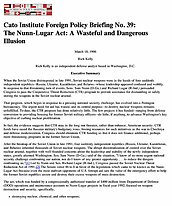That program, which began in response to a pressing national security challenge, has evolved into a Pentagon bureaucracy. The urgent need for aid has waned, and its central purpose–to destroy nuclear weapons-remains unfulfilled. To date, the CTR program has done relatively little. The few projects it has funded–ranging from defense conversion to providing housing for former Soviet military officers–do little, if anything, to advance Washington’s key objective of curbing nuclear proliferation.
In fact, the evidence suggests that CTR may in the long run threaten, rather than enhance, American security. CTR funds have eased the Russian military’s budgetary woes, freeing resources for such initiatives as the war in Chechnya and defense modernization. Congress should eliminate CTR funding so that it does not finance additional, perhaps more threatening, programs in the former Soviet Union.
After the breakup of the Soviet Union in late 1991, four suddenly independent republics (Russia, Ukraine, Kazakhstan, and Belarus) inherited thousands of Soviet nuclear weapons. The abrupt decentralization of control over the Soviet nuclear arsenal, together with well-founded concerns about the leadership and stability of the newly independent states, greatly alarmed Washington. Sen. Sam Nunn (D‑Ga.) said of the situation, “I know of no more urgent national security challenge confronting our nation, nor do I know of any greater opportunity … to reduce the dangers confronting us.”[1] Led by Nunn and Sen. Richard Lugar (R‑Ind.), Congress passed the Soviet Nuclear Threat Reduction Act of 1991.[2] The Senate voted 86 to 8 in favor of the legislation-which came to be known as the Nunn-Lugar Act-because even the most stalwart opponents of U.S. foreign aid saw the value of the emergency effort to help the former Soviet republics secure and destroy their excess weapons of mass destruction.
The act, which was funded by a congressionally authorized transfer of $400 million from Department of Defense (DOD) operations and maintenance accounts to Nunn-Lugar projects in fiscal year 1992, focused on weapon destruction and security, specifically,
- destroying nuclear, chemical, and other weapons;
- transporting, storing, disabling, and safeguarding weapons to be destroyed; and
- establishing verifiable proliferation safeguards.
In January 1992 Harvard University’s Ashton Carter, a prominent academic involved in the creation of the Nunn-Lugar program, detailed its requirements.[3] He wrote that, in response to the congressional authorization to spend $400 million, the administration should develop a plan for assisting in moving, storing, and destroying the former Soviet Union’s nuclear weapons. The plan-to be “worked out with” authorities from the new republics, experts from the international community, and the former Soviet nuclear weapons complex-would proceed in five stages: (1) inventorying, tagging, and securing weapons; (2) relocating weapons to perhaps 25 storage sites; (3) dismantling the weapons; (4) placing materials in long-term storage; and (5) cleaning up nuclear facilities.
With the advent of the Clinton administration in January 1993, Carter became assistant secretary of defense for nuclear security and counter proliferation, one of two assistant defense secretaries with responsibility for the CTR program.[4] The Defense Nuclear Agency was in charge of selecting and paying the U.S. contractors that would perform the work and consume the funding.[5]
A mismatch has developed between the CTR programs lofty aims-reducing the former Soviet Union’s nuclear threat to the United States-and what it has done-to date, very little. The lack of accomplishment may be a blessing, however, because the CTR program has not had the opportunity to waste much money or implement projects that could produce dangerous results. The path to understanding what has gone wrong leads in two directions: to the former Soviet Union and to the Pentagon.

